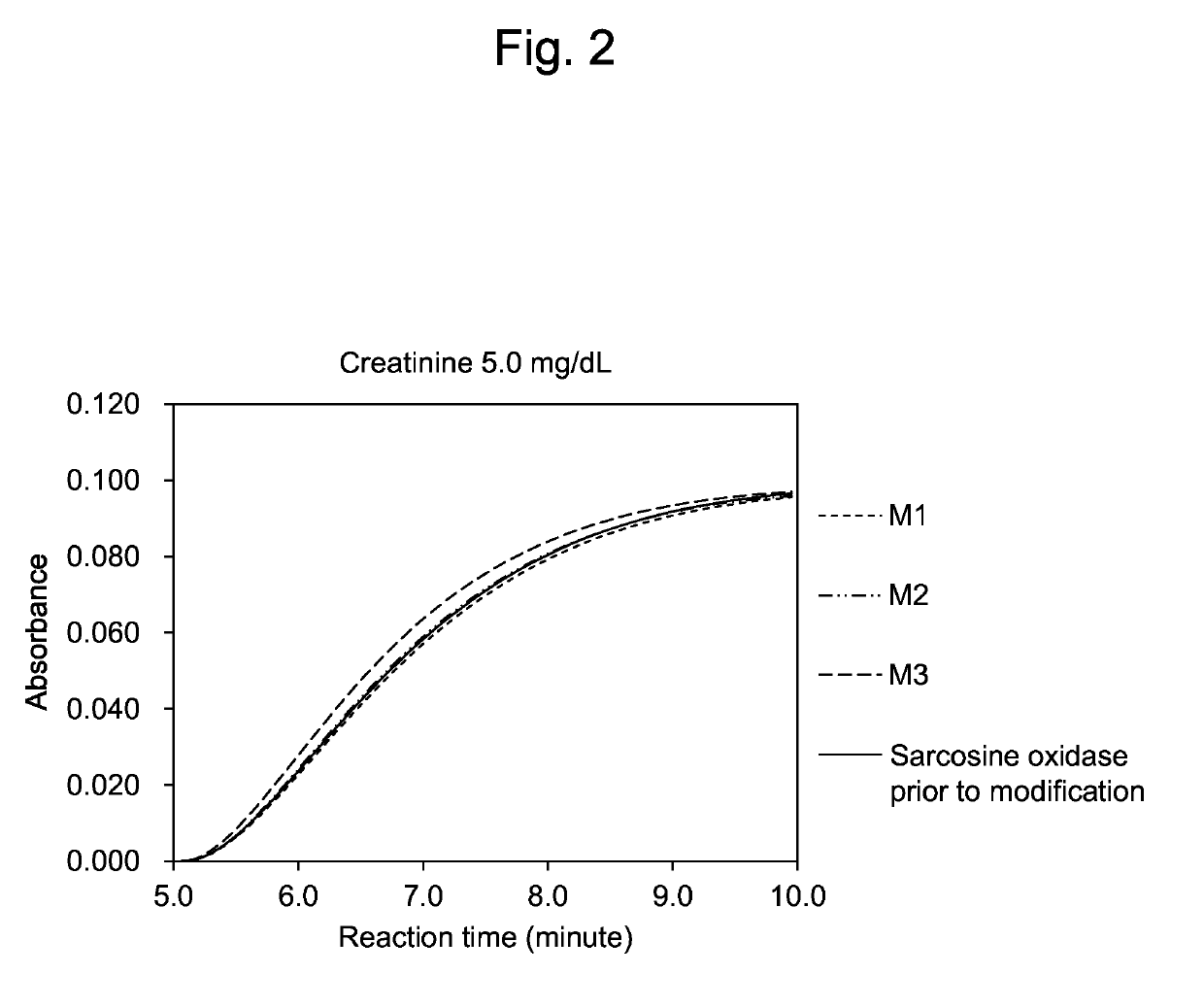Modified sarcosine oxidase, and gene and production method therefor
- Summary
- Abstract
- Description
- Claims
- Application Information
AI Technical Summary
Benefits of technology
Problems solved by technology
Method used
Image
Examples
example 1
[0071]Escherichia coli (E. coli) DH5α (pSON), containing a recombinant plasmid DNA (a vector obtained by incorporating the SON gene of SEQ ID NO: 1 into the vector pUTE300K′, hereinafter described as pSON) was cultured in an LB culture medium (manufactured by Difco Laboratories Incorporated), and the bacterial bodies were collected. Subsequently, the recombinant plasmid DNA pSON was extracted and purified therefrom using the GenElute Plasmid Miniprep Kit (Sigma-Aldrich Co. LLC.). The obtained recombinant plasmid was about 100 μg.
[0072]Based on the obtained recombinant plasmid, error-prone PCR was carried out using primers for the N-terminus and C-terminus (SEQ ID NOs: 5 and 6). Error-prone PCR was performed using the GeneMorphII EZClone Domain Mutagenesis Kit (manufactured by Agilent Technologies, Inc.). After the reaction, E. coli DH5α (manufactured by NIPPON GENE CO., LTD.) was transformed using a library of sarcosine oxidase genes having various mutations introduced, and mutant s...
example 2
[0081]Among the mutants obtained as above, Escherichia coli (E. coli) DH5α comprising the modified sarcosine oxidase gene of M1, M2 or M3 was subjected to shaking culture in 100 ml of a TY culture medium (1% bacto-tryptone, 0.5% bacto-yeast extract, 0.5% NaCl, pH 7.5) containing 25 μg / ml kanamycin at 37° C. for 16 hours. Then, 10 ml of the mixture was inoculated into 7 L of a TY culture medium prepared in the same manner (however, 1 mM of IPTG is included). After the inoculation, this was cultured at a number of revolutions of 120 r.p.m. and 37° C. for about 20 hours.
Step 1 (Preparation of Crude Enzyme Solution)
[0082]After culturing, 7 L of the culture solution was passed through a UF membrane (MW 50000), to remove culture medium components and then, was replaced with a 10 mM phosphate buffer with 1 mM EDTA. To this was added EDTA (pH 8.0) to a final concentration of 50 mM, and the mixture was treated with a high-pressure homogenizer to disrupt the bacterial bodies. The disrupted ba...
example 3
[0086]Reactivity of the modified sarcosine oxidases M1, M2 and M3 purified by the method mentioned above and the sarcosine oxidase prior to modification to L-proline were compared using enzyme solutions in which the sarcosine activities were standardized to about 33.0 U / ml. Incidentally, phenol was used as the coloring agent in the present reaction.
[0087]The results are shown below. When the relative activity of the sarcosine oxidase prior to modification to substrates is defined as 100%, the relative activity ratio of the modified sarcosine oxidase M1 to L-proline was 51.5%, that of M2 was 73.0%, and that of M3 was 68.7%.
TABLE 3Relative activity ratios of purified mutantsM1, M2 and M3 to wild type (%)4.8 mM Sar / 95 mM Pro / 95 mM Sar(%)95 mM Sar(%)Wild type100100M195.351.5M290.173.0M3110.568.7
PUM
| Property | Measurement | Unit |
|---|---|---|
| Fraction | aaaaa | aaaaa |
| Fraction | aaaaa | aaaaa |
| Fraction | aaaaa | aaaaa |
Abstract
Description
Claims
Application Information
 Login to View More
Login to View More - R&D Engineer
- R&D Manager
- IP Professional
- Industry Leading Data Capabilities
- Powerful AI technology
- Patent DNA Extraction
Browse by: Latest US Patents, China's latest patents, Technical Efficacy Thesaurus, Application Domain, Technology Topic, Popular Technical Reports.
© 2024 PatSnap. All rights reserved.Legal|Privacy policy|Modern Slavery Act Transparency Statement|Sitemap|About US| Contact US: help@patsnap.com










